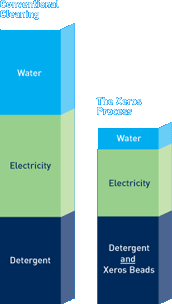
Like many breakthrough ideas, the origin of the Xeros cleaning process was borne from transferring known science in one world to an entirely different world, unrestricted by conventional thinking. Leeds University, one of the UK’s leading textile institutes, has a long history of working with textile manufacturers. Their leading polymer chemist, Professor Stephen Burkinshaw, concentrated on how to improve anchoring dye onto fabrics. His big insight was to recognise that dyes are just like stains.
So if he knew how to anchor dyes onto fabric, why not reverse this expertise and think how to use fabric polymers to remove stains? After extensive R&D with his University team of scientists, he found the best polymer was nylon due to its unique property to become highly absorbent in humid conditions. Better still, it is highly resilient so can be re-used time after time without losing its strength. After all, the ropes used on ocean liners are made of nylon!
The nylon polymer has an inherent polarity that attracts stains. Think of how your white nylon garments can get dingy over time as dirt builds up on the surface despite constant washing. However, under humid conditions, the polymer changes and becomes absorbent. Dirt is not just attracted to the surface, it is absorbed into the centre. This is exactly what happens when Xeros nylon beads are gently tumbled with dampened garments.

Comments by our Users
Be the first to write a comment for this item.